Deborah J. Ross's Blog, page 75
December 7, 2018
[personal] My Love/Hate Relationship with Chanukah
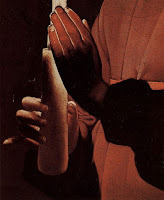 For the past decade or so, whether Chanukah falls in early December or overlaps Christmas, I have wrestled with the meaning of the holiday. I grew up in a devoutly secular Jewish family, although my father used to tell us stories of the holidays. It wasn’t until I had children of my own that observing Jewish customs became important to me. Their father, my first husband, came from a family that celebrated Christmas as a paean to overconsumption, an amalgam of showering each other with cheap gifts and gorging on indigestible food while sniping at one another. In our own home, however, we would have a modest tree, a modest meal, and presents that had something to do with the interests of the recipients.
For the past decade or so, whether Chanukah falls in early December or overlaps Christmas, I have wrestled with the meaning of the holiday. I grew up in a devoutly secular Jewish family, although my father used to tell us stories of the holidays. It wasn’t until I had children of my own that observing Jewish customs became important to me. Their father, my first husband, came from a family that celebrated Christmas as a paean to overconsumption, an amalgam of showering each other with cheap gifts and gorging on indigestible food while sniping at one another. In our own home, however, we would have a modest tree, a modest meal, and presents that had something to do with the interests of the recipients.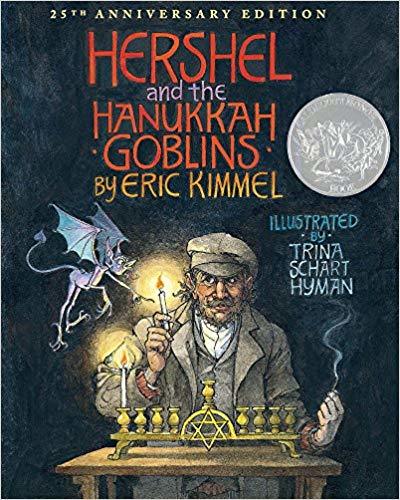 So where did Chanukah fit it? For one thing, when my kids came along I decided not to compete with Christmas. No big gatherings. No tinsel. No horribly unhealthy meals. And no presents. Instead, we turned off the tv, and gathered around to light the candles and stumble through reading the blessings. We’d play dreidel using Chanukah gelt (foil-wrapped chocolate coins) and take turns reading aloud from a collection of funny children’s Chanukah books. The hands-down favorite was Eric Kimmel’s Herschel and the Hanukkah Goblins, although his The Chanukkah Guest came a close second. One of the appeals of Herschel was the way the dialog of the goblins lent itself to silly voices as Herschel outwitted them one by one. Needless to say, the kids loved reading together and playing games as a family. Years later, they told me that they didn’t want to give the impression they didn’t like getting presents for Christmas but they liked Chanukah better.
So where did Chanukah fit it? For one thing, when my kids came along I decided not to compete with Christmas. No big gatherings. No tinsel. No horribly unhealthy meals. And no presents. Instead, we turned off the tv, and gathered around to light the candles and stumble through reading the blessings. We’d play dreidel using Chanukah gelt (foil-wrapped chocolate coins) and take turns reading aloud from a collection of funny children’s Chanukah books. The hands-down favorite was Eric Kimmel’s Herschel and the Hanukkah Goblins, although his The Chanukkah Guest came a close second. One of the appeals of Herschel was the way the dialog of the goblins lent itself to silly voices as Herschel outwitted them one by one. Needless to say, the kids loved reading together and playing games as a family. Years later, they told me that they didn’t want to give the impression they didn’t like getting presents for Christmas but they liked Chanukah better.As the kids grew up, and I divorced and later remarried, I found myself re-evaluating the holiday. I hadn’t celebrated it as a child and I no longer had children to delight. By this time, my own Jewish identity had become increasingly important to me. What did this holiday mean, beyond a way of enjoying the winter in a non-specifically-Christian way?
I started reading the story behind Chanukah, and that’s when my troubles started.
The history as it’s usually told is fairly straightforward, this version from the website Judaism 101:
Alexander conquered Syria, Egypt and Palestine, but allowed the lands under his control to continue observing their own religions and retain a certain degree of autonomy. Under this relatively benevolent rule, many Jews assimilated much of Hellenistic culture, adopting the language, the customs and the dress of the Greeks, in much the same way that Jews in America today blend into the secular American society.
More than a century later, a successor of Alexander, Antiochus IV was in control of the region. He began to oppress the Jews severely, placing a Hellenistic priest in the Temple, massacring Jews, prohibiting the practice of the Jewish religion, and desecrating the Temple by requiring the sacrifice of pigs (a non-kosher animal) on the altar. Two groups opposed Antiochus: a basically nationalistic group led by Mattathias the Hasmonean and his son Judah Maccabee, and a religious traditionalist group known as the Chasidim, the forerunners of the Pharisees (no direct connection to the modern movement known as Chasidism). They joined forces in a revolt against both the assimilation of the Hellenistic Jews and oppression by the Seleucid Greek government. The revolution succeeded and the Temple was rededicated.
According to tradition as recorded in the Talmud, at the time of the rededication, there was very little oil left that had not been defiled by the Greeks. Oil was needed for the menorah in the Temple, which was supposed to burn throughout the night every night. There was only enough oil to burn for one day, yet miraculously, it burned for eight days, the time needed to prepare a fresh supply of oil for the menorah. An eight day festival was declared to commemorate this miracle. Note that the holiday commemorates the miracle of the oil, not the military victory: Jews do not glorify war.
Unpacking that a bit, the history is usually framed as a victory for freedom of religion (“they oppressed us, defiled the Temple, etc., but we resisted and triumphed, so now we get to worship in our own way”) with the miracle of the oil lasting 8 days as proof of divine approval. As one season after another rolled around, I felt increasingly uneasy about this. I didn’t see how this was not glorifying war (see the last sentence in the article above) by celebrating a military victory. I couldn’t understand how you could reasonably separate the “miracle” of the oil and the “we took back our Temple by force of arms.” Not persuasion, not diplomacy, not compromise. Not libertarian “do you your thing.” Not even voting on the issue.
Brute strength.
This did not sit well with me. For one thing, setting aside my commitment to nonviolent solutions, it means that if one side were winners, the others lost. People aren’t thrilled about losing, by the way. The feelings fester into resentment and the thirst for retribution. Every 3 year old knows this.
Then I started considering those losers, those soldiers dying far from home. Not being a scholar of Greek history, I don’t know if they had a choice to enlist, or if they did so out of loyalty or from hope of a better life. I did know I didn’t feel good about celebrating their deaths. I couldn’t escape the connection. Sometimes it felt as if I were lighting candles for the peace of their spirits.
Matters got even worse when I looked even more carefully at the story. I began to see the conflict not as Greek oppressors versus those who sought only to worship as they chose. It was a conflict within the Jewish community between hard-liners who wanted to keep all the power within the priestly caste and those who saw commonality and good in the world in which they were increasingly assimilated. I suspect the heads of the Maccabees would explode if they knew how many modern Jews also practice Buddhist meditation, yoga, or celebrated…Christmas.
At this point, I’d like to say a few more words about Christmas. It’s nigh onto impossible to ignore, growing up in a Western country. I’ll set aside the pagan (or not) origins of many of the traditions and just say that much of the holiday has little or anything to do with practicing Christianity. I love the music and the foods and the fragrances (fresh-cut pine trees! oranges stuck with cloves! hot cider with cinnamon sticks! clove-scented ribbon candy!). I love that the ideal is for us to set aside our differences in the spirit of “peace on earth and good will toward all.” I loved walking through gently falling snow, serenading the faculty members of my college, each singer holding a lighted candle.
In fact, I love the idea of lighting candles in the darkest time of the year. I cherish things that bring us together instead of separating us. This is not to say that all of us must be alike. Each family’s, community’s, ethnicity’s particular history has its own unique value. I just don’t want to be jumping up and down for joy because my “side” won.
There’s a deeper issue here, which is Who has the power? Who is making the rules? A small group of priests (men, of course) who want things done the way they always have been? The pioneers and experimenters who answer to their own consciences? We ourselves, flawed and imperfect as we are? One of the many things I appreciate about modern Judaism is the insistence upon finding our own understanding (“Two Jews, Three Opinions”).
Well, my opinion is that I get to make up my own mind how to celebrate Chanukah.
During this personal journey, an image that recurred to me came from the television series Babylon 5. At the end of the second season, as the Shadows are closing in and the future looks grim, Susan Ivanova stands in a darkened room, lighting Chanukah candles. She was not just one Jewish woman, she was me. She was all of us, yearning for hope in dark times and bringing tiny points of light into a troubled time. The more I thought about it, the more this image helped me to reclaim Chanukah. It doesn’t have to be about “the miracle of the oil” or the victory of the Maccabees. It can be whatever is meaningful to me. That’s the “free to worship as we choose” part.
So this year I lit candles with my family and contemplated the wiliness of Herschel of Ostropol in outwitting the Goblin King and all his hench-goblins. I will greet my gentile friends with whatever holiday wishes they like. I give myself permission to enjoy it all.
If there is a miracle for me in Chanukah, it’s the resilience of the human spirit and our ability to take a difficult passage and find in it a message of universal hope.

Published on December 07, 2018 01:00
December 5, 2018
Today's Moment of Art
Published on December 05, 2018 01:00
December 3, 2018
Sword and Sorceress 33 Author Interviews: Dave Smeds
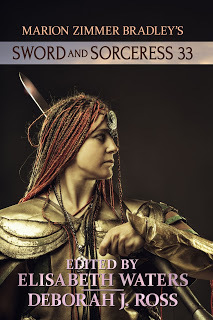 Enter a wondrous universe…the latest volume of Sword and Sorceress, featuring stories from new and seasoned authors. Herein you will find tales of fantasy with strong female characters, with some version of either martial skill or magic. Not all the protagonists will be human, and sometimes the magic will take highly original forms, but the emotional satisfaction in each story and in the anthology as a whole, remains true to the original vision. The release date will be November 2, 2018.
Enter a wondrous universe…the latest volume of Sword and Sorceress, featuring stories from new and seasoned authors. Herein you will find tales of fantasy with strong female characters, with some version of either martial skill or magic. Not all the protagonists will be human, and sometimes the magic will take highly original forms, but the emotional satisfaction in each story and in the anthology as a whole, remains true to the original vision. The release date will be November 2, 2018. ePub: https://www.books2read.com/u/b62gG6Kindle: https://amzn.to/2NitlHH
Deborah J. Ross: Tell us a little about yourself. How did you come to be a writer?
Dave Smeds: I loved fiction from an early age. I was particularly drawn to stories of imaginary worlds, or at least by settings that were in effect imaginary, such as Mars as depicted by Edgar Rice Burroughs. At age fifteen, it occurred to me I might be able to write a short story or two. I did that. The result was crap, of course, but every time I did another story or fragment of a novel, I could see how to improve. (It was, as you might imagine, REALLY OBVIOUS how I could improve.) I felt driven to eventually write something at a level I'd want to read if someone else had written it.
DJR: What inspired your story in Sword and Sorceress 33?
DS: Six years ago, when pondering what I would write for Sword and Sorceress 27, I decided it was the right time to initiate a story sequence. A number of S&S contributors have resorted to the series format. I had not done so, other than my gullrider tales in S&S 4 and S&S 5. In my teens I very much enjoyed the Conan stories. Part of the joy of those -- speaking now of Howard’s original eighteen tales, not of the scads of pastiches that have been added to the canon over the seventy years -- is that he skipped around, presenting views of his character at various stages of life, in all sorts of settings. I also greatly appreciated the economy and focus of a sequence made up of short-fiction installments. It’s so much work to devour a series made up of four or six or eight novels, but four or six or eight short stories? Great from an author perspective, and hopefully great from a reader perspective as well. Somehow the image of my characters making a getaway on a flying carpet came to me, and that led to the first outing of my characters Coil and Azure. I like coming up with original worlds too much to limit my S&S contributions to nothing but Coil and Azure stories, but I had not featured them since S&S 29 and I missed them, so here we go for at least one more time with “The Citadel in the Ice.” At this point I have no idea how soon I’ll do another installment. I promised myself to do them only when the muse is really nagging me.
DJR: What authors have most influenced your writing? What about them do you find inspiring?
DS: In the early days, I never thought of myself as deeply influenced by any particular author, except perhaps in the sense that I loved to write sword-and-sorcery, and back then, anyone doing that was standing on the shoulders of Robert E. Howard and J.R.R. Tolkien. In retrospect, I see L. Frank Baum's influence upon the way I structure a story. Baum did not write The Hero's Journey. He wrote The Heroine's Journey. That is to say, he wrote books in which the protagonist -- usually a girl -- makes alliances, as opposed to the Campbell paradigm where a young man pulls himself up by the bootstraps, stands alone, and takes sole credit for defeating an antagonist. I prefer the complexity and subtlety of The Heroine's Journey.
DJR: Why do you write what you do, and how does your work differ from others in your genre?
DS: At first I wrote to prove I could do it. Next I wrote to earn money. Both motivations, in my view, demanded that I write the best work I could, so in that respect, I have no regrets. But I write now with the awareness that an author of fiction has an obligation to inject meaning into an essentially meaningless universe. That's our job as human beings. We are creatures of pattern recognition. It's our chief survival trait. A fiction writer must do it better than anyone. That’s a challenge. However, at this point in my life I feel I have fulfilled my former writing goals and what keeps me putting the words down on the chance it will fill an existential void for someone out there.
DJR: How does your writing process work?
DS: My process would drive any other writer nuts, I suspect. The ideas -- whether it is for a scene, a character, a setting, a plot, a premise -- bubble up and I go with what fascinates me at the moment. I see the whole story and fill in the pieces almost randomly as if assembling a jigsaw puzzle. I might write the ending first. I might write a little bit that fits two-thirds of the way along. it's just about unheard of that I proceed from page one to the end in chronological order. I think that's happened only three or four times in forty-eight years of writing, and only with very short pieces.
DJR: What have you written recently? What lies ahead?
DS: In terms of output, I've slowed down tremendously in the past fifteen years. Lately quite a bit of my creative work has been on the art side of my career, doing covers of other authors' books. For example, I have done a lot of the Sword and Sorceress covers. The big thing on the horizon is the novel The Wizard's Nemesis, the final volume of my War of the Dragons trilogy. I would have been done with a complete draft last autumn, but the evening I sat down to begin the final push to get the last fragment of it done, there was this thing called the Sonoma County firestorm that drove my family and I out of our home for nine days, and left me in a jittery and non-creative mood.
DJR: What advice would you give an aspiring writer?
Shamelessly plagiarize Neil Gaiman and George R.R. Martin.
Dave Smeds sold his first story in early 1979 to the anthology Dragons of Light, edited by
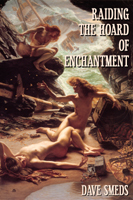
Orson Scott Card. He describes himself as a non-prolific writer, but has nevertheless sold hundreds of stories since then. In addition, he has written novels, screenplays, comic book scripts, reviews, and articles, primarily in the arena of science fiction and fantasy. His work ranges across a variety of sub-genres, but he particularly enjoys crafting imaginary-world fiction. He has done so for the Sword and Sorceress series nearly twenty times.
Deborah's note: The beautiful cover design for Sword and Sorceress 33 is by Dave Smeds.

Published on December 03, 2018 01:00
November 30, 2018
Short Book Reviews: Bram Stoker and the Raiders of Ancient Egypt
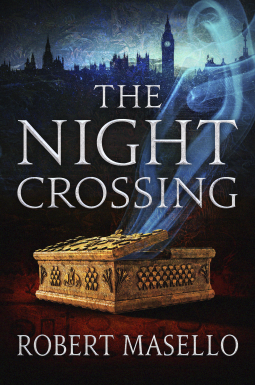 The Night Crossing, by Robert Masello (47North)
The Night Crossing, by Robert Masello (47North)Loosely falling into the category of historical urban fantasy, this delicious tale places Bram Stoker, author of Dracula, center-stage. Literally, since Stoker ran the theater that featured Henry Irving, the first actor to be knighted. And figuratively, since this is essentially Bram’s adventure. In the 19th Century, “Egyptomania,” enthusiasm for all things ancient Egyptian, swept Western Europe. Ordinary travelers as well as serious scholars pillaged archaeological sites looking for treasure and curiosities, which they of course brought back to England. Never mind the damage done by amateurs to the archaeological sites. To be sure, some artifacts ended up with serious collectors who cared about provenance and preservation. Accounts relate “mummy unwrapping parties.” People apparently considered a fine way to pass an evening with port wine and removing the coverings of a mummy, searching for small articles folded in the bandages, which were then distributed as trinkets. (Some scholars now dispute these accounts, although not those of scholars holding similar public events.)
In the world of urban historical fantasy, Egyptian burial practices involve supernatural elements, including the ability to prolong life and reanimate the dead. Bram, searching for a high-concept premise to launch his literary career from obscurity into best-seller territory, takes notice when he runs afoul of a brother and sister duo who are using Egyptian magic to do just that.
Enter (Minerva) Mina Harcourt, intrepid Anglo-Romany adventurer, her century’s female Indiana Jones. While investigating the monumentally huge Carpathian sphinx (there really is such a thing), she comes into possession of a mysterious golden box (see the cover image). Enter also Lucinda Watts, a timid young woman who works in a match factory (owned by the brother of the above-referenced nefarious pair), suffers from phossy jaw (formally known as phosphorus necrosis of the jaw, from the white phosphorus used in match manufacture) and is the mother of an illegitimate son (the brother being a rapist, as well) who dies when the evil duo suck out his soul. (That’s an approximate summation of the process, which is actually more than a bit more complex.)
Before long, Bram and Mina are on the hunt not only for the Egyptian immortality thieves but the origin of her golden box and the shadows that mysterious escape from it. The mash-up of historical setting and real personages, the fictional inspirations for Stoker’s Dracula, and the dramatic twists and turns make this a delicious and occasionally shiver-producing thriller. The narrative style, rich in detail, atmosphere, and well-drawn personalities, kept me turning pages even through the parts of slower action. The variation in pace allowed for context, nuance, and emotional resonance, making The Night Crossing more than just a “fun read.” I’ll be on the lookout for more from this sensitive, skillful writer.
The usual disclaimer: I received a review copy of this book, but no one bribed me to say anything about it.

Published on November 30, 2018 01:00
November 28, 2018
Today's Moment of Art
Published on November 28, 2018 01:00
November 26, 2018
Sword and Sorceress 33 Author Interview: Marella Sands
 Enter a wondrous universe…the latest volume of Sword and Sorceress, featuring stories from new and seasoned authors. Herein you will find tales of fantasy with strong female characters, with some version of either martial skill or magic. Not all the protagonists will be human, and sometimes the magic will take highly original forms, but the emotional satisfaction in each story and in the anthology as a whole, remains true to the original vision. The release date will be November 2, 2018.
Enter a wondrous universe…the latest volume of Sword and Sorceress, featuring stories from new and seasoned authors. Herein you will find tales of fantasy with strong female characters, with some version of either martial skill or magic. Not all the protagonists will be human, and sometimes the magic will take highly original forms, but the emotional satisfaction in each story and in the anthology as a whole, remains true to the original vision. The release date will be November 2, 2018. ePub: https://www.books2read.com/u/b62gG6Kindle: https://amzn.to/2NitlHH
Marella has a multitude of pets who are slowing destroying her carpeting but are too cute to be angry with. When she is not feeding the furry bottomless pits or taking them to the vet, she is more-or-less methodically making her way through her Netflix watchlist. Currently, she is watching The Great Interior Design Challenge, which has proven to her that she has absolutely no ambition to become an interior designer. This is her second story in Sword and Sorceress; the previous story, “Tortoise Weeps,” was in Sword and Sorceress XIII.
Deborah J. Ross: What have you written recently?
Marella Sands: I'm finishing up revisions on an alternate history novel with a tangled real-life backstory. I belong to a writers group called the Alternate Historians, none of whom write alternate history. The name was chosen in the early days of the group, and the people who voted for the name left soon after, so the group name has never matched what anyone in the group actually writes. Another member (Mark Sumner) and I decided to change that around 1994, because Mark wanted to produce a cable-access show that would be a fantasy/alternate history. We wrote a script, but by the time we finished it, the cable-access idea had faded, and we tried to market it through our agent instead. That didn't work out, so the script was mothballed. Then, in 2017, I was asked if I'd like to submit an alternate history novel to a small press, and so the idea was un-mothballed. Mark wasn't interested in pursuing the project, but gave me his blessing, so I've been working on that. A few more scene changes and it should be ready to go. Hopefully, it will be what the editor is looking for!
DJR: What lies ahead?
MS: Like many writers, I have too many projects that I want to get to. I want to take another
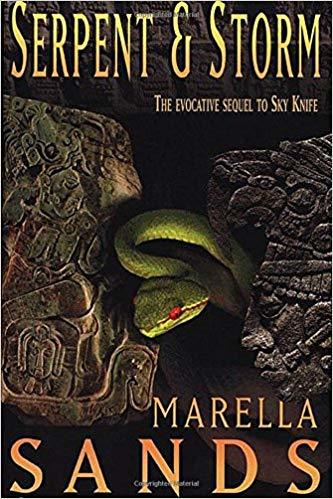 look at a novel I wrote ten years ago that got glowing rejections. There are more short stories that want to get told, and I am still trying to get back to my series of novellas about a bartender caught up in a war between fallen angels. I wanted to have six or seven of those done by now, but short stories like the one in this anthology, and the alternate history novel, have meant I am only on the third at this point.
look at a novel I wrote ten years ago that got glowing rejections. There are more short stories that want to get told, and I am still trying to get back to my series of novellas about a bartender caught up in a war between fallen angels. I wanted to have six or seven of those done by now, but short stories like the one in this anthology, and the alternate history novel, have meant I am only on the third at this point.
Published on November 26, 2018 01:00
November 23, 2018
Darkover Novel News

For those of you who like to follow such things, I've begun work on the next Darkover novel, Arilinn, about the founding of that Tower. I've been fleshing out the outline, and am about to begin writing the text itself. Go, me! Stay tuned for updates. If you'd like a sneak peek now and again, subscribe to my newsletter here.

Published on November 23, 2018 17:17
Short Book Reviews: Vampires and Ogres and Were-Dragons, Oh My!
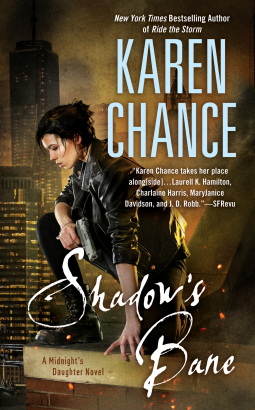 Shadow's Bane, by Karen Chance (Berkley)
Shadow's Bane, by Karen Chance (Berkley)Elsewhere I have written about the challenges of picking up a book in the middle of a series, and it’s worth repeating here:
“Series” can mean a number of things, from stand-alone complete-in-themselves novels set in the same universe to one long story that extends over several volumes. Recently I listened to an interview with Peter Jackson in which he discussed the decision to not put a recap at the beginning of The Two Towers, the second part of The Lord of the Rings. He felt that one year between film was a short enough time for viewers (those few not intimately familiar with the books) to remember and anyone who went to see it without having seen or read The Fellowship of the Ring, oh well… I admit to not being as careful as I might about checking to see if a book is a sequel, so I rely on the skill of the author to furnish necessary backstory without inundating me with it, and to draw me into the story so that even if I have to work a little harder to figure out what has gone before, I’m already hooked.
I began Shadow’s Bane without realizing it was “yet another adventure” in a series. To the ultimate credit of the author, for most of the book, I honestly could not tell if there was separate backstory (previous volumes) or if this was a brilliantly executed, complex novel that wove in aforementioned backstory, world-building, and characters, all while sweeping me up in a dramatic, action-driven plot.
The world is fascinating, multi-layered, and rich in its own history. Vampires exist, as do dhampirs (vampire-human hybrids, heartily loathed by both parent races), ogres, fae, mermaids, were-creatures, and magicians. Relations between the various races are uneasy at best and impossible to summarize here. Our heroine, Dory/Dorina, in addition to being dhampir, suffers from split personality that’s the result of her (vampire) father attempting to save her from her worser (waaaay worser) nature. So there’s a nice internal conflict, as well as rather spicy romance with a master vampire, a sweet friendship with a human woman who has (a) given birth to the heir to a fairy kingdom; (b) turns out to be a were-dragon, so don’t get her pissed, and various other friendships and enemyships.
My one complaint about this fast-paced, intricately plotted novel is that Dory is constantly flying off the handle, reacting instead of thinking things through or, better yet, asking questions and then listening to the answers. She’s supposed to be hundreds of years old and has apparently never learned the value of information, perspective, or taking a deep breath and counting to ten. As a result of this and her almost pathological lack of self-esteem, quite avoidable misunderstandings abound. That would be okay if it were just one character, but this world seems to be populated with folks who do the same thing. It’s a wonder they haven’t blown themselves up by acting hastily instead of with deliberation. To be fair, I liked that there were very few all-good or all-evil characters, and at the same time, people changed their minds, learned, and grew.
That quibble aside, this is a fun story that moved right along, doesn’t require any previous knowledge of the series, and comes together very nicely in the end.
The usual disclaimer: I received a review copy of this book, but no one bribed me to say anything about it.

Published on November 23, 2018 01:00
November 21, 2018
Today's Moment of Art
Published on November 21, 2018 01:00
November 19, 2018
Sword and Sorceress 33 Author Interviews: Deirdre M. Murphy
 Enter a wondrous universe…the latest volume of Sword and Sorceress, featuring stories from new and seasoned authors. Herein you will find tales of fantasy with strong female characters, with some version of either martial skill or magic. Not all the protagonists will be human, and sometimes the magic will take highly original forms, but the emotional satisfaction in each story and in the anthology as a whole, remains true to the original vision. The release date will be November 2, 2018.
Enter a wondrous universe…the latest volume of Sword and Sorceress, featuring stories from new and seasoned authors. Herein you will find tales of fantasy with strong female characters, with some version of either martial skill or magic. Not all the protagonists will be human, and sometimes the magic will take highly original forms, but the emotional satisfaction in each story and in the anthology as a whole, remains true to the original vision. The release date will be November 2, 2018.ePub: https://www.books2read.com/u/b62gG6Kindle: https://amzn.to/2NitlHH
Deborah J. Ross: Tell us a little about yourself. How did you come to be a writer?Deirdre M. Murphy: When I was a kid, I felt like books were my best friends. They brought me a lot of joy and led, in the end, to me being less lonely in real life and finding human friends who understood me. I wanted to be one of the storytellers, to give those gifts forward, in part, and to, in a sense, play with the storytellers I’d admired for so long, whether or not I got to meet them in person.
DJR: What inspired your story in Sword and Sorceress 33?DMM: A panel at a science fiction convention. We were discussing monsters as metaphor, and there was one pretty obvious metaphor that hadn’t been used much, which combined with the thought that dysfunctional behaviors are often functional behaviors done wrong, or occasionally the function is just misunderstood.
DJR: What authors have most influenced your writing? What about them do you find inspiring? DMM: This question is too big for a short interview! I love stories that surprise me, that make me think, that give me a window into a different world or into understanding people who are unlike me in some fundamental way.
DJR: How does your writing process work?DMM: I’m a night writer, mostly. There’s something about the mystery of the darkness, and the quiet that happens when most people around me are dreaming that just works for me. As to the stories themselves, sometimes I get a flash of imagery, or a character, or a situation and just sit down and write as fast as my fingers will go. That’s delightful, when it happens, but a lot of the time it’s like anything worthwhile, there’s parts that are fun, parts that are fascinating and challenging, and parts that you just have to slog though.
DJR: What have you written recently? What lies ahead?DMM: I’m currently working on a cozy mystery with sea monsters. If that becomes popular, I’ll doubtless do more about the same characters. I’m fond of them.If the cozy mystery doesn’t catch, I have some catkin characters in an alternate Chicago, who don’t know they have a city to save. Yet. I’m fond of them too, though I have fewer words invested in them so far.I also have edits waiting for a YA novel about a girl and her snow-unicorns. But right now, I’m having fun with my amateur sleuth just happening to be underfoot when the professionals have told her to leave the investigation to them.
DJR: Where else can readers find you?DMM: I have a Patreon at https://www.patreon.com/Wyld_Dandelyon. I put at least one “something new” there every week. Sometimes it’s a photograph I took and an accompanying haiku, and other times it’s more elaborate. I’ve put ficlets and character studies there for supporters, and I have some chapters of my Quirky Writer’s Guide to Courting Inspiration and Foiling Writer’s Block up there. There’s a number of posts that are visible to the public, and some just for my supporters. I am also Wyld_Dandelyon on Dreamwidth and twitter.
DJR: What advice would you give an aspiring writer?DMM: Write. Live. Write some more. Live some more. Read. Laugh. Revise. Send some random kindness and beauty out into the world. Live deep and wide. Keep writing.
Deirdre M. Murphy is a writer, poet, artist, and singer-songwriter whose first professionally published story appeared in Marion Zimmer Bradley's FANTASY Magazine.Since then her work has appeared in various venues including Crossed Genres; Trafficking in Magic, Magicking in Traffic; and Tails of the Pack. She is one of the primary creators of Torn World, with stories, art, and award-winning poetry set in an original science fantasy world at www.tornworld.net.

Published on November 19, 2018 01:00









